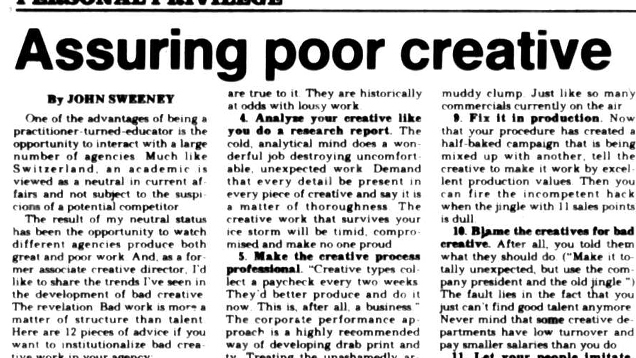10 Ways to Assure Poor Creative
In 1986, John Sweeney, an associate director at a then-tiny creative agency known as FCB, wrote a column in Advertising Age titled “Assuring Poor Creative.” It’s a sarcastic take on the pitfalls of cultivating great work. In classic copywriter fashion, Sweeney listed the ways an organization could ensure the creation of dull, forgettable creative work.

If you’re a professional marketer, odds are a colleague has asked you to produce something “creative.” That’s an intimidating request. Because no word is more subjective or overused:
- When do your ideas become creative?
- How do you ensure their “creativeness”?
- How do you measure the creative quotient of your work?
Truth is, creativity is messy. Creativity is subjective. Creativity is personal. Like fashion or a joke, not everyone “gets” the same things. That’s why more and more companies are placing a premium on bringing creative people onboard.
And most glaringly, creativity shifts with the culture—and modern culture is in constant flux.
So in 2017, the rules that Sweeney outlined in 1986 remain applicable—perhaps even more so than when he wrote them 30 years ago: Our audiences are attention-deficit and fragmented unlike never before. And while our methods of consumption have changed, the principles underlying memorable, effective creative work have not.
If you find that your company is cranking out the same flaccid ideas—and realizing the same underwhelming results—you can probably find the culprit in these “rules.”
10 Rules to Assure Poor Creative
1. Treat your target audience like a statistic.
Never has so much data been collected about so many faceless people. In 2017, analytics rule the roost. But relying solely on metrics ignores the deeper insights you gain from thinking of your audience as diverse, complicated human beings. Don’t overgeneralize your users. Go the extra step to discover what’s behind all those spreadsheets.
2. Make your strategy a hodgepodge.
Back in 1986, Americans’ attention spans were miniscule. Three decades later, it’s practically extinct. So if you want your message to fall on deaf ears, strive to be all things to all people. Nothing will confuse or fatigue your audience more than selling them everything under the sun. In an age when content consumption and attention fragmentation is the norm, bite-sized (byte-sized?) messaging is your only hope of permeating your stressed, busy audience.
3. Have no philosophy.
Organizations need to stand for something. You need to stand for something. Your audiences won’t give a whit about you until they know who you are. Be confident enough to embrace a point of view; then demonstrate it. Actions will always speak louder than words, but nothing stops you from speaking passionately.
4. Analyze your creative like you do a research report.
Creative concepts that are overanalyzed and fully explained to the audience kill spontaneity and the thrill of experiencing the unexpected. This applies to user experience design, copywriting, identity, graphic design, illustration—anything. If you want to create a moment of delight, give your messages the freedom of interpretation.
Thoughts on design delivered to your inbox
5. Make the creative process “professional.”
Developing campaigns and imagery doesn’t fall in step with a corporate workflow. If you treat your creative process like a 9-5, you’ll get 9-5 work. Instead, give your staff autonomy and self-direction. Cultivate a work environment that promotes intrinsic motivation and the benefits of self-rewarding work.
6. Say one thing and do another.
In today’s era of social consciousness, authenticity reigns supreme. If your marketing makes a promise you cannot keep, you audience has already figured that out. Be who you are. Don’t over-promise. Don’t deceive. The truth will win out.
7. Give your client the candy store.
Designers know half-baked ideas are faster to prototype and develop. Consequently, it’s easy to present a kaleidoscope of run-of-the-mill ideas when you’re running low on originality or strong storytelling. Focus on quality over quantity when presenting choice to stakeholders. Take the time and invest the money necessary to do one brilliant thing instead of a dozen useless ones.
8. Mix and match your campaigns.
The dreaded Franken-design! A little bit of this, a little bit of that, a sprinkling of whatever these are. And voila! Your ideas droop and your messaging loses its edge. This pitfall is often the result of having too many cooks in the kitchen. Better (usually) to let one person drive the creative.
9. Let your staff imitate.
Every single second:
- 7,456 Tweets are tweeted
- 786 Instagram photos are uploaded
- 2.6 million emails are sent
Great (and not so great) headlines, videos, blog articles, and videos bombard us all day. And yet, there’s room for new ideas to cut through the content glut—if they’re exceptional. Imitation sets a very low bar across your organization and fundamentally discredits the talent you and your team possess.
10. Believe testing only when you get a good score
We’ve left Nielsen scores in the dust. Today, A/B testing is the norm and a creative department’s best tool. The ability to tweak, iterate, and then tweak again is something every designer and marketer should embrace. This gives our ideas room to breathe and educates your stakeholders that no piece of messaging is permanent. Just be sure to face the results, good or bad.
The Big Takeaway
There you have it. The process and form our work takes will constantly be in flux. What we can count on is that content creators will always be king, and people will always love engaging moments full of insight, craft, and uniqueness.
So next time you sit down to knock out a layout, a line of copy or a hashtag, know your audience will always define what “creative” truly means.

